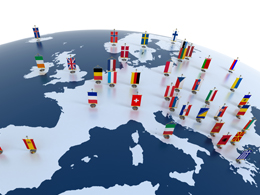 I wrote yesterday about what I see as the two major domestic risks to the U.S. economic recovery, neither of which is worth worrying about too much. The two immediate risks we should be thinking about originate outside the U.S.: the standoff between Germany and Greece, and the confrontation between Europe and Russia.
I wrote yesterday about what I see as the two major domestic risks to the U.S. economic recovery, neither of which is worth worrying about too much. The two immediate risks we should be thinking about originate outside the U.S.: the standoff between Germany and Greece, and the confrontation between Europe and Russia.
It’s no coincidence that the real risks come from Europe. While China, for example, remains a risk, it is in many respects like the U.S.—a continental power, overwhelmingly dominant in its area, with a unified government and substantial financial resources. Any trouble there is likely to develop slowly. Japan is in much the same situation.
Only Europe combines extensive economic troubles with a political infrastructure that cannot address those problems in a unified way. Plus, it’s confronting Russia, another major local power intent on pushing conflict.
Europe’s confrontation with Russia
Although many thought the Ukraine situation would be resolvable, the Russians have continued to up the ante, moving in more men and equipment, and moving into more territory within Ukraine—the first military invasion in a major European state since World War II. Worse, there is talk of Russia using this kind of hybrid, deniable invasion strategy in the Baltic countries, which are NATO treaty allies.
Why would Russia do this? The short answer is something approaching desperation. Geopolitical analysts have pointed out that Ukraine is a key part of the Russian defense sphere, and losing it to the other side—no matter the reason—places the rest of the country at risk. Imagine, for example, if Texas voted to leave the U.S. and ally itself with Russia. The two are not comparable, of course, but that gives you some idea of what Russia sees when it looks at a Western-oriented Ukraine.
The other critical Russian problem is economic. I will do an outside-view analysis of Russia soon, but briefly, Russia’s economy depends on exporting oil. With the current low prices, Russia simply doesn’t work. Sanctions imposed by Europe and the U.S. are making things even harder.
It’s from an American song, but the line “Freedom’s just another word for nothing left to lose” does a pretty good job of describing Russia’s position with respect to Europe and the U.S. When you get backed into a corner, things that might seem crazy to others could be your only options.
The Greek situation
“Backed into a corner” also describes Greece’s situation, and that feeling surely drove the election of the Syriza movement. Syriza came to power on the promise of ending austerity, bringing back government funding, and doing it all in the context of eurozone membership. While the markets seem to think Syriza was just kidding, recent actions suggest the new government really means it. With a desperate Greece demanding more funding, Germany now has to decide whether keeping Greece in the eurozone is worth writing more checks.
The real question here is who’s more desperate: Greece or Germany? I suspect the answer is Greece. Its current situation is so bad that the pain of leaving the euro may well be worth it. Germany, on the other hand, is far from desperate, at least economically. With the many benefits Germany gets from the eurozone, it probably makes economic sense to continue writing checks rather than see Greece leave. That, of course, is what the Greeks are betting on.
What does all this mean for the U.S.?
Both of these major international risks come from countries in positions so difficult that actions that would otherwise look crazy start to make sense (at least to them). In a larger context, the idea of a European war—and remember, the U.S. is now talking about providing weapons to Ukraine—or a breakup of the eurozone would cause great damage, but that may not matter to either Russia or Greece.
Thanks to our closed economy, the direct effects of either event on the U.S. would be small. The indirect effects could be substantial, particularly through the global financial system, but this time we have advance warning. The biggest impact would be to reset expectations for risk levels and future growth, which could hit the stock market hard. On the other hand, there would be offsetting benefits, such as a flight to safety and new desire for U.S. assets, which could mitigate any downside.
Overall, these are real risks, but neither is likely to unfold into the worst-case scenario. In any event, the U.S. remains better positioned than most other countries to ride out potential damage, and any negative effects would be less damaging here than elsewhere.


 Print
Print


